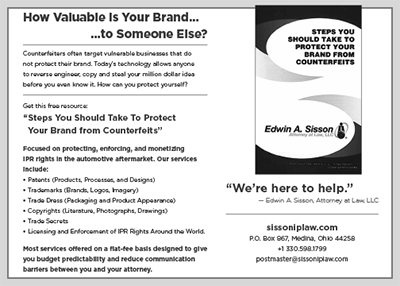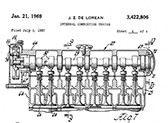CNC machining and 3D printing technologies have opened entire new worlds for parts manufacturers and engine builders alike. Modern machinery can seemingly make whatever part you can dream of with amazing specificity and repeatability.
Sadly, others can and will use these same technologies to reverse engineer and copy your parts. The availability of these technologies has led to an influx of copycat, knock-off and counterfeit parts; slashing your market share and reducing your return on your product development investments.
Intellectual property rights (IPR) can help protect your new product developments against unauthorized copying. In this two-part series, we will explore the IPR tools available for protecting your innovations and brands (Part 1), and steps you can take to enforce your IPR against unauthorized copying (Part 2).

People incorrectly think of IPR strictly in terms of utility patents and trademarks; these are only two of many tools in your IPR toolbox. Your IPR toolbox also includes design patents, trade dress and copyrights.
Utility Patents
Utility patents are typically your first line of defense when protecting new products. A utility patent protects the functionality of invented products and processes. Just filing a patent application has value as it allow you to mark your product as “Patent Pending‚” a simple step that can deter would-be copycats.
We tend to think of patents in terms of groundbreaking inventions like the lightbulb, the telephone or the internal combustion engine. However, patents are not limited to cutting-edge innovations. The U.S. Patent and Trademark Office has granted over 10 million patents in its 200+ year history‚ most of which cover incremental improvements to existing technologies. For example, while cylinder heads have been in existence since the advent of the internal combustion engine, my search of U.S. Patent and Trademark Office records found over 7,500 granted patents since 1976 with claims relating to cylinder heads for engines, including several granted in 2019.
You must meet three basic requirements to obtain a patent. First, your invention must be new. In other words, your invention must not have been previously disclosed‚ such as in a previous patent or in a magazine article. Second, your invention must be non-obvious. Obviousness typically results when a first disclosure comes close to your invention, and one or more secondary disclosures can be used to bridge the gap between the first disclosure and your invention. Finally, your invention must be useful. Usefulness is a low standard, which you can usually meet if your invention is capable of doing anything at all.
A word of caution regarding the “new” requirement – any disclosure to anyone can thwart your invention from being new. So, when you send out a news release about your new product, or display it at a trade show (SEMA, PRI, etc.) without first having filed a patent application, you risk cutting off your ability to obtain a patent. Accordingly, you should always consult with a patent attorney before launching a new product.
In the U.S., utility patents are protected federally through the U.S. Patent and Trademark Office. For companies selling internationally, almost every country has its own patent office where you can obtain patents to protect yourself overseas.
Design Patents
If utility patents protect the functional features of a newly invented product, design patents protect the aesthetic features. Design patents have been used to protect everything from the appearance of Apple’s iPhone (United States Design Patent No. D834,013) to Nike’s Air Jordan shoes (United States Design Patent No. D400,000) to various car designs such as Ford’s Mustang (e.g. United States Design Patent No. D710,762). While these iconic designs provide excellent examples, design patents are used to protect many different industrial and consumer products.
Design patents are an effective tool for combating counterfeiting. Counterfeiters often mimic the overall appearance of a product to entice unsuspecting consumers to purchase their products. In some cases, the counterfeiter will even add unnecessary tool marks to their products simply because those same tool marks appear on the genuine product that they are trying to copy. While the counterfeit may not function the same as the genuine product, consumers may still purchase it because it “looks like the real thing.” Using design patents to protect the aesthetic features of your new products can be a powerful tool to prevent this type of counterfeiting.
Design patents are subject to the same new and non-obvious requirements as utility patents. Like utility patents, design patents are protected federally at the U.S. Patent and Trademark Office, and most countries have their own design patent system.
Trademarks
Trademarks protect brand names, logos and marketing slogans that help consumers identify the goods or services they are buying come from your company. For example, when consumers see a winged foot logo on a tire, they know they are purchasing a tire manufactured by The Goodyear Tire & Rubber Company.
A good trademark has three key features. First, it is unique in that it has no prior association with your goods or services. Second, it is distinctive. In other words, it is easy to remember. Finally, it is non-descriptive in that it does not simply describe your goods or services.
Trademarks do more than prevent others from duplicating your brand image. Trademarks also protect you against third parties who use variations of your branding that are likely to cause confusion in the mind of an ordinary consumer of your products. For example, if you used Ford Motor Company’s blue oval emblem to sell cars, but spelled Ford in a different font you would likely still face a trademark infringement lawsuit from Ford.
Your trademark rights start from the moment you begin using a brand name, logo or slogan with your goods or services. You can also register trademarks federally at the U.S. Patent and Trademark Office, or at the state level. Registration strengthens the value of your trademark and opens additional enforcement mechanisms, which we’ll discuss in Part 2. Like patents, most countries have their own trademark office where you can register your trademarks.
Trade Dress
Trade dress bridges the gap between trademarks and design patents. Trade dress is a specific type of trademark that protects the appearance of products and their packaging. Trade dress has been used to protect everything from the Coca-Cola bottle (United States Trademark Registration No. 1,057,884) to Duracell batteries (United States Trademark Registration Nos. 1,152,937 and 1,144,787) to the appearance of gas stations (e.g. United States Trademark Registration No. 4,359,913).
Businesses often use trade dress as a way to maintain protection over their product appearance after a design patent has expired. However, trade dress should not be confused with design patents. While design patents can cover virtually any aesthetic feature of a product, trade dress can only protect features that identify the source of goods.
To be registered or enforced, trade dress must be distinctive and non-functional. Distinctive means that the product or packaging appearance can be used to identify the source of goods. Non-functional means that the particular appearance is not essential to use of the product, and does not affect the cost or quality of the product.
Like trademarks, trade dress rights come into existence the moment you begin using the appearance of your goods or their packaging as a source identifier. However, you can register your trade dress at the U.S. Patent and Trademark Office. Internationally, trade dress rights vary from country to country. You should consult with a qualified trademark attorney before pursuing trade dress rights internationally.
Copyrights
Copyrights protect “artistic works” such as books, magazine articles, photographs, drawings, music and the like. For businesses, copyrights can be used to protect marketing materials such as catalogs and trade show displays, as well as product manuals and installation instructions.
Many counterfeiters will not bother to make a functional or aesthetic copy of your product. Instead they will attempt to trick unsuspecting consumers into purchasing their inferior product by using your own marketing materials in their advertising. Owning the copyright to those materials can help to address counterfeiting activity – particularly on e-commerce sites.
A copyright exists the moment an artistic work is created. At that moment, ownership of the copyright rests with its creator (i.e., the author or artists). For businesses the copyright ownership should be immediately assigned from the creator to the business.
Copyrights can also be registered federally at the U.S. Copyright Office. Registration affords you with certain additional rights – including the right to sue for statutory damages of up to $30,000 per copy. Internationally, most countries have their own copyright office where you can register your copyrights.
Your IPR toolbox contains a variety of valuable tools that you can use to protect your new innovations and your branding. IPR protections work best when you integrate them into your business strategy early. If you wait to protect your IPR until after you’ve already encountered a copycat, it is often too late.
In Part 2 of this series (coming in May 2019), we will look closer at strategies for enforcing your IPR in the U.S. and internationally. Sneak peek – enforcing against counterfeiters in China may be easier than you think.










